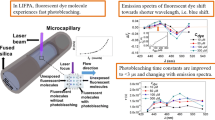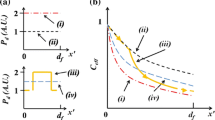Abstract
A method to measure fluid speeds on the order of 10,000 mm/s in microchannels is presented. A microfluidic protein mixer is manufactured with a 170 µm microscope coverslip bottom that interfaces with a confocal florescence microscope using a water-immersed Olympus UPLSAPO 60XW objective to create a diffraction-limited confocal volume. A diode laser with a repetition rate of 1 MHz is used to study Poiseuille flows at average speeds of 5000, 6000 and 7000 mm/s by exciting tris(2,2′-bipyridine)ruthenium(II) hexafluorophosphate solution at 1 μmol/L concentration flowing through the micro-mixer in the confocal volume. Decays collected using a time-correlated single photon counting card at each grid point are characterized by the first moment of the decay and curve fitted with the theoretical Poiseuille flow solutions. It was found that curve fitting with higher average speeds results in lower errors. A fluorescence correlation study was then carried out at different depths in the micro-mixer to understand the raw data profiles observed using the diode laser. A mixing study was then carried out using a Ti-Sapphire laser with a repetition rate of 3.8 MHz. A Poiseuille flow at 7000 mm/s was measured using the Ti-Sapphire laser and then curve fitted to the theoretical Poiseuille flow solution. The curve fit was then applied to the complicated flow region to determine speed. Results of the experimental mixing study are also compared to direct numerical simulation results.
Graphical abstract
An experimental technique to measure speeds in the complicated mixing region of a protein mixer is developed. Results show that when flow is bounded asymmetrically between a rough wall and smooth wall, the flow shows affinity for the smooth wall during the mixing process. The Reynolds number for this is flow is 245 indicating flow in the transitional turbulence regime.



















Similar content being viewed by others
References
Acton FS (1959) Analysis of straight-line data. Wiley, New York
Bostock L, Chandler S, Rourke C (1982) Further pure mathematics. Nelson Thornes, Cheltenham, p 410
Buschmann V, Krämer B, Koberling F, Macdonald R, Rättinger S (2009) Quantitative FCS: determination of the confocal volume by FCS and bead scanning with the microtime 200. Application Note PicoQuant GmbH, Berlin
Courant R, Friedrichs K, Lewy H (1967) On the partial difference equations of mathematical physics. IBM J Res Dev 11:215–234
Cox G, Sheppard CJ (2004) Practical limits of resolution in confocal and non-linear microscopy. Microsc Res Tech 63:18–22
Gobby D, Angeli P, Gavriilidis A (2001) Mixing characteristics of T-type microfluidic mixers. J Micromech Microeng 11:126
Inguva V, Kathuria SV, Bilsel O, Perot BJ (2018) Computer design of microfluidic mixers for protein/RNA folding studies. PLoS One 13:e0198534
Jiang X, Lai C (2016) Numerical techniques for direct and large-eddy simulations. CRC Press, Boca Raton
Kathuria SV, Chan A, Graceffa R, Paul Nobrega R, Robert Matthews C, Irving TC, Perot B, Bilsel O (2013) Advances in turbulent mixing techniques to study microsecond protein folding reactions. Biopolymers 99:888–896
Kinoshita H, Kaneda S, Fujii T, Oshima M (2007) Three-dimensional measurement and visualization of internal flow of a moving droplet using confocal micro-PIV. Lab Chip 7:338–346
Ku HH (1966) Notes on the use of propagation of error formulas. J Res Natl Bur Stand 70:263–273
Li H, Olsen MG (2006) Examination of large-scale structures in turbulent microchannel flow. Exp Fluids 40:733–743
Majumdar ZK, Sutin JD, Clegg RM (2005) Microfabricated continuous-flow, turbulent, microsecond mixer. Rev Sci Instrum 76:125103
Martell MB, Rothstein JP, Perot JB (2010) An analysis of superhydrophobic turbulent drag reduction mechanisms using direct numerical simulation. Phys Fluids 22:065102
Matsumoto S, Yane A, Nakashima S, Hashida M, Fujita M, Goto Y, Takahashi S (2007) A rapid flow mixer with 11-µs mixing time microfabricated by a pulsed-laser ablation technique: observation of a barrier-limited collapse in cytochrome c folding. J Am Chem Soc 129:3840–3841
Natrajan V, Christensen K (2009) Structural characteristics of transition to turbulence in microscale capillaries. Phys Fluids 21:034104
Nguyen N (2011) Micromixers: fundamentals, design and fabrication. Elsevier, Oxford, pp 28–36
Park JS, Choi CK, Kihm KD (2004) Optically sliced micro-PIV using confocal laser scanning microscopy (CLSM). Exp Fluids 37:105–119
Perot JB (2011) Determination of the decay exponent in mechanically stirred isotropic turbulence. AIP Adv 1:022104
Pope SB (2001a) The scales of turbulent motion. In: Turbulent flows, pp 184–187
Pope SB (2001b) Wall flows. In: Turbulent flows, p 270
Schermelleh L, Heintzmann R, Leonhardt H (2010) A guide to super-resolution fluorescence microscopy. J Cell Biol 190:165–175. https://doi.org/10.1083/jcb.201002018
Shinohara K, Sugii Y, Aota A, Hibara A, Tokeshi M, Kitamori T, Okamoto K (2004) High-speed micro-PIV measurements of transient flow in microfluidic devices. Meas Sci Technol 15:1965
Tanaami T, Otsuki S, Tomosada N, Kosugi Y, Shimizu M, Ishida H (2002) High-speed 1-frame/ms scanning confocal microscope with a microlens and Nipkow disks. Appl Opt 41:4704–4708
Van Houten J, Watts RJ (1976) Temperature dependence of the photophysical and photochemical properties of the tris (2,2′-bipyridyl)ruthenium(II) ion in aqueous solution. J Am Chem Soc 98:4853–4858
Van Oort B, Amunts A, Borst JW, Van Hoek A, Nelson N, Van Amerongen H, Croce R (2008) Picosecond fluorescence of intact and dissolved PSI-LHCI crystals. Biophys J 95:5851–5861
Williams SJ, Park C, Wereley ST (2010) Advances and applications on microfluidic velocimetry techniques. Microfluid Nanofluidics 8:709–726
Zettner C, Yoda M (2003) Particle velocity field measurements in a near-wall flow using evanescent wave illumination. Exp Fluids 34:115–121
Zusi CJ, Perot JB (2013) Simulation and modeling of turbulence subjected to a period of uniform plane strain. Phys Fluids 25:110819
Acknowledgements
We would like to thank NSF for funding this work. The work is supported by NSF IDBR Award no. 1353942. We would like to thank Yvonne Chan at University of Massachusetts Medical School for providing assistance in the wet laboratory. We would like to thank the reviewers for their constructive feedback that significantly improved this paper. We acknowledge the Texas Advanced Computing Center (TACC) at The University of Texas at Austin for providing HPC, visualization and database resources that have contributed to the research results reported within this paper. http://www.tacc.utexas.edu.
Author information
Authors and Affiliations
Corresponding author
Additional information
Publisher’s Note
Springer Nature remains neutral with regard to jurisdictional claims in published maps and institutional affiliations.
Electronic supplementary material
Below is the link to the electronic supplementary material.
Rights and permissions
About this article
Cite this article
Inguva, V., Rothstein, J.P., Bilsel, O. et al. High-speed velocimetry in microfluidic protein mixers using confocal fluorescence decay microscopy. Exp Fluids 59, 177 (2018). https://doi.org/10.1007/s00348-018-2630-0
Received:
Revised:
Accepted:
Published:
DOI: https://doi.org/10.1007/s00348-018-2630-0




